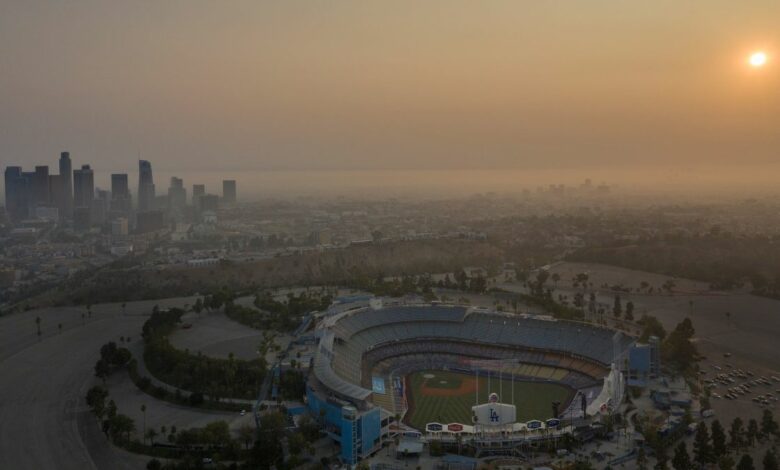
About 1 in 4 people in the United States – more than 119 million residents – live with air pollution that can hurt their health and shorten their lives, according to a new report from the American Lung Association. People of color are disproportionately affected, as are residents of Western cities.
Since President Richard Nixon signed the Clean Air Act in 1970, emissions of outdoor air pollutants have fallen 78 percent, according to the US Environmental Protection Agency. But Wednesday’s 2023 State of the Air report, which focuses on ozone and particle pollution, shows that millions put their health on the line every time they step outside.
Cleaner air, but not for all
To capture pollution levels at the county level, researchers analyzed data collected by the EPA’s Air Quality System, a repository of ambient air quality data from more than 10,000 monitors. They characterized the hourly average ozone concentration and the 24-hour average particle pollution concentration for 2019-21 at each monitoring site and factored in year-round pollution information from the EPA.
There were significant improvements in some areas. Generally, 17.6 million fewer people were breathing unhealthy air than in last year’s report, due largely to falling levels of ozone in some regions.
Ozone pollution is the main ingredient in smog. It comes from cars, power plants and refineries. Exposure to ozone can immediately exacerbate asthma symptoms, and people with long-term exposure to higher levels face a significantly higher risk of death from respiratory diseases than those who live with cleaner air.
Around 25 percent more counties got an A grade in the report for lower levels of ozone pollution. Some of that improvement can be attributed to the Clean Air Act, according to Katherine Pruitt, author of the report and the American Lung Association’s national senior director for policy.
Emission controls have helped, she said, as has the country’s continuing move away from its reliance on coal for its energy needs. Even something simple as the increase in the number of people who work from home has played a role.
“The Biden administration has set themselves a good, strong to do list of things that will help with environmental justice and climate protection,” Pruitt said. “They’re moving kind of slow, though. So we’d like them to pick up the pace.”
Despite the progress, not everyone was lucky enough to live in a county with good ozone levels. More than 100 million people live in counties that get an F for ozone smog, the report says.
Western and Southwestern cities are the most ozone-polluted, with 10 of the 25 most-polluted cities in California. New York, Chicago and Hartford, Connecticut, were the only three on that list east of the Mississippi River.
The five metropolitan areas with the worst ozone pollution are Los Angeles-Long Beach, California; Visalia, California; Bakersfield, California; Fresno-Madera-Hanford, California; and Phoenix-Mesa, Arizona.
Problematic particle pollution
Particle pollution, the other form of pollution tracked in the report, still seems to be a significant issue for the US.
Often hard to see, particle pollution is a mix of solid and liquid droplets that may come in the form of dirt, dust, soot or smoke. Coal- and natural gas-fired power plants create it, as do cars, agriculture, unpaved roads, construction sites and wildfires.
Particle pollution is so tiny – 1/20th of a width of a human hair – that it can travel past your body’s usual defenses.
Instead of being carried out when you exhale, it can get stuck in your lungs or go into your bloodstream. The particles cause irritation and inflammation and may lead to respiratory problems. Exposure can cause cancer, stroke or heart attack; it could also aggravate asthma, and it has even been associated with a higher risk of depression and anxiety, studies show.
The new report says the number of people living in counties with failing grades for daily spikes of particle pollution was the highest it has been in a decade. Nearly 64 million live with these kind of unhealthy spikes in counties that get failing grades.
One driver of the high amounts of particle pollution are the wildfires that have consumed hundreds of thousands of acres. In 2021 alone, there were 14,407 fires, many in the West, according to the National Interagency Fire Center. There used to be a wildfire season, experts say, but now they happen year-round.
Those fires are why the regions with the highest concentrations of air pollution are largely in the West.
When the American Lung Association started producing its report in 2004, 106 counties in 30 states got failing grades for daily spikes in particle pollution. Fewer than half were in eight states west of the Rocky Mountains. Today, 111 counties in 19 states got Fs for spikes in particle pollution, and all but eight counties are in the West, the report says.
Urban centers in the Rust Belt and the industrialized East had gotten the most failing grades in the early 2000s, but many have cleaned up and now get passing grades.
Bakersfield, California, displaced Fresno as the metropolitan area with the worst short-term particle pollution, but Fresno did not suddenly develop cleaner air. That city still had the most-polluted label for year-round particle pollution, tied with Visalia, in the agricultural San Joaquin Valley.
Los Angeles is still the city with the worst ozone pollution, according to the report, as it has been for all but one of the years included in the report.
California has some of the more progressive environmental legislation in the country, but the climate crisis has not been kind to the state, said Tarik Benmarhnia, an air pollution and wildfire researcher at the University of California, San Diego, who did not work on the new report.
“All these cities like Bakersfield and Visalia are in a valley near the forests that are seeing big fires. There’s also intense agricultural and industrial work there, so they unfortunately have all the worst conditions for air pollution,” Benmarhnia said.
There are some newcomers to the list of the 25 areas with the most particle pollution, including Denver and Fargo, North Dakota. Reno, Nevada; Yakima and Spokane, Washington; and Boise, Idaho; all made the worst list this year.
San Luis Obispo, California; Portland, Oregon; and Seattle and Bellingham, Washington; all moved off the list of worst 25 cities.
Residents in the cities ranked worst for particle pollution are living with more of it, the report says. In the top 25 cities with the worst air, the average number of days residents were exposed to high levels of fine particle pollution increased to a weighted average of 18.3, up from 16.5 in last year’s report.
East of the Mississippi, Pittsburgh and Lancaster, Pennsylvania, were the two worst metropolitan areas in the country, posting more days high in fine particle pollution in this year’s report.
Unequal exposure
Not everyone experiences pollution the same way in the US. Regardless of the region, communities of color bear the brunt of the problem.
Specifically, although people of color make up 41 percent of the overall US population, they are 54 percent of the nearly 120 million people living in counties with at least one failing grade for unhealthy air. And in the counties with the worst air quality, 72 percent of the 18 million residents are people of color, the report said.
Other research has also shown this trend. On maps that lay out areas with high levels of air pollution and where communities were redlined – areas where Black people were forced to live – they line up perfectly, Pruitt said.
“Then, the other aspect is, when you have a community of color that is a voluntary community, people aren’t forced to live there, those are communities that tend to have less of a voice, so decision makers place polluting sources in those communities because there’s not as much howling by people with power when they do. So those communities get the highways; they get the landfills; they get the fence lines,” she said.
There’s a myth that only poor communities live with disproportionate pollution levels, says Chris Tessum, a professor in the Civil and Environmental Engineering Department of the University of Illinois. Tessum, who was not involved in the new report, says race really is the determining factor.
“The thinking is that people with more money will buy better property, which has lower air pollution and that’s just the way of the world or whatever, but that’s just kind of emphatically not, not true,” he said.
Solutions to pollution
Communities need to play a key role in making decisions to help clean air, Tessum said.
“People that have the power will use that power to benefit themselves and not the people that have been historically overburdened,” he said.
The new report says government and residents can make a difference. One suggestion is to leverage Inflation Reduction Act funding to help reduce emissions at ports and to invest in zero-emission heavy-duty vehicles and in infrastructure that would improve air quality monitoring.
States can also use the Clean Air Act authority to adopt the California zero-emissions standards for cars and trucks, the report says.
At the federal level, agencies must finalize stronger limits on air pollution to truly protect public health and advance environmental justice, the report says, including standards to move the country toward zero-emissions vehicles. The EPA also has to set stronger national standards for particle pollution and ozone, the researchers say.
Pruitt said she knows firsthand how better policies can work. She said growing up before the Clean Air Act, pollution was so high that she could see it every time she stepped outside. Today, the pollution is not nearly as visible.
“I’m in my mid-60s, and of course, air pollution was very tangible when I was young, but these days, thank goodness it isn’t. Most people don’t see it,” she said. Unless a person has a lung condition, they may not even feel it.
But just because you can’t see it or feel it doesn’t mean it’s not there. Pruitt encourages people to remember that no level of pollution is safe. The World Health Organization estimates that the combined effects of ambient air pollution and household air pollution are associated with 6.7 million premature deaths annually.
“People don’t really recognize that what they’re breathing is impacting their health,” Pruitt said.




